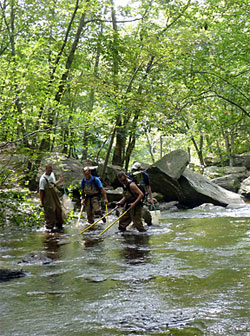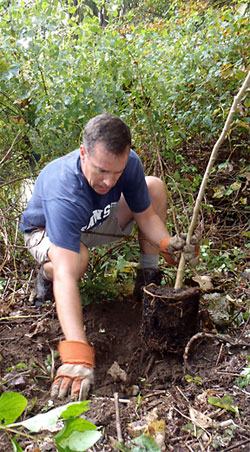Nutmeg Chapter Stream Restoration/Preservation Activities
As do other chapters of Trout Unlimited in Connecticut and nationwide, we carry out locally TU’s mission through grassroots work to clean up and restore local waters. The rivers and streams we care for here are the lower estuary of Housatonic River, the Mill River, the Far Mill River, the Pequonnock River, Hawley’s Brook, the Saugatuck River, the Halfway River, Sasco Brook, and the Aspetuck River.

We’ve been committed to protecting these streams since the chapter was founded in 1973 and some of our accomplishments include:
- Working with the Connecticut Department of Energy and Environmental Protection on construction of the flyfishing-only section on the Saugatuck River
- Spearheading the removal of a dam preventing fish movement and migration on the upper Mill River Wild Trout Management Area which was featured in the Fall 2010 issue of Trout, TU’s national magazine
- Monitoring our local steams and ensuring they’re cared for by attending town and state meetings and writing letters to town, state, and federal officials. We had a very strong influence, through direct provision of data and position paper/letters on the recent streamflow regulations passed into law in the State of Connecticut and FERC re-licensing of the Falls Village, CT hydro-electric dam. The latter ended the practice of ponding-and-releasing on the upper Housatonic River when its hydroelectric license was renewed in 2005
- Working with local and town governments to make improvements to our streams and rivers such as invasives removal and installation of natural planting/structure streamside buffer zones such as one completed this past spring on the Pequonnock River at Old Mine Park in Trumbull
Mill River Improvement Project

Our most important current stream restoration work is the Mill River Improvement Project (MRIP) which consists of restoring and protecting the Mill River, one of only nine Class A Wild Trout Streams left in our state out of over 300 streams. The Mill is unique in that it is pure enough and cold enough to sustain wild trout despite being on the edge of an extremely suburban area. The MRIP watershed plan will map out specific steps for the river’s health and conservation involving the Connecticut Department of Energy and Environmental Protection and other state and municipal authorities and land trusts.
One key step already underway is to remove invasive plant species such as oriental bittersweet, winged euonymus and Japanese barberry and re-plant native species such as elm, bank willow and spice bush now being crowded out. This is re-establishing ecologically natural buffer zones resulting in lowered water temperatures crucial for survival of native brook trout.
Our work will also involve in-stream natural structural improvements including rock weirs and boulders to provide refuge crucial for the survival of our wild trout, and bank erosion prevention and restoration using natural soil retention materials.
A longer-range goal is to extend, with the cooperation and authority of the CT DEEP, the Wild Trout Management Area (WTMA) which is catch-and-release fishing only, all the way from the Easton Reservoir section currently a WTMA down to Lake Mohegan in Fairfield, an additional extension of two miles of the river. This will make this fishery unique — In no other place in the State of Connecticut is there a tail-water wild trout fishery that flows freely to a 60-foot deep lake, providing excellent natural spawning, feeding and protective features vital for wild brown and brook trout to survive and thrive.